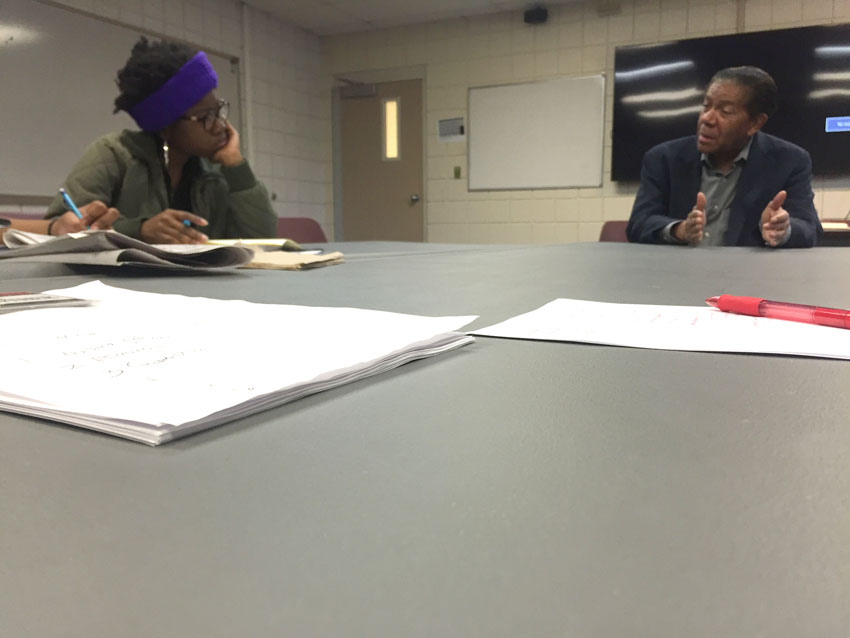Cecil Williams’ photos key part of Claflin’s history
By: Panther staff
Feb 09, 2019

Cecil Williams talks about the Claflin archives project during a news conference with The Panther.
Cecil Williams has chronicled Claflin University's history for a half-century.
Preserving the noted Orangeburg civil rights photographer’s work is a priority for retiring President Dr. Henry N. Tisdale during the university’s 150 anniversary year and beyond, Williams said Jan. 29 during a news conference with The Panther.
“It was one of the most wonderful things in my entire life,” Williams said of Tisdale’s vision to preserve the collection. Williams is the university's director of historic preservation, being named to the position by Tisdale.
The preservation process involves digitizing Williams’ works as Claflin’s official photographer as well as his images from the civil rights era in Orangeburg, the state and beyond. Williams’ negatives may comprise the largest collection of civil rights photographs in the world.
Work began more than three years ago on preserving the images, a project supported through funding by the Gaylord Donnelley Foundation. More than 70,000 photos have been preserved.
But there are many more to go. Williams is unsure of how many negatives are in his total collection but said they could number more than 400,000.
In a lab located in the H.V. Manning Library, the digitization of film negatives began in October 2015. Student interns began working in 2017.
Working collaboratively with the student interns and Williams in the project are Library Director Marilyn Gibbs Drayton and Library Specialist Barbara Green.
The subjects and pioneers captured in the Cecil Williams Collection include individuals who emerged and were engaged in waves of change that impacted the world from 1950 through 1996, when film was mostly replaced by digital technology.
The magnitude of the imaging project at Claflin is that it not only guarantees the preservation of the university’s legacy, it also establishes Claflin as a leading repository of images that encapsulate a pivotal period in American history.
Eventually, after the digitization procedures, the entire Cecil Williams film negative collection will be housed at Claflin.
The digitization procedures undertaken by the student interns were performed with a device invented by Williams that allows film captures nearly 60 times faster than any other method. Williams’ creation, the FilmToaster, came about in 2015.
Previously it took 30 seconds a minute to scan each negative on a flatbed scanner, Williams said. He sought a solution to the laborious process designed to preserve images from deteriorating film negatives.
The FilmToaster takes a photo of the negatives in less than 5 or 6 seconds, he said.
Williams debuted the FilmToaster at the New York Photo Expo in October 2015. More than 500 have been sold around the world since, he said.
Williams, who has worked for JET Magazine and owns a photography studio, Cecil Williams Photography LLC, began taking photos in 1947 at the age of 9.
A native of Orangeburg, he was inspired to pursue photography when his brother gave him a hand-me‐down Kodak Brownie.
By age 15, Williams was working as a professional photographer for publications such as JET magazine, the Afro‐American newspaper and the Pittsburgh Courier. He was also a stringer for the Associated Press.
Following his graduation from Claflin, Williams used his camera to capture significant milestones in the civil rights movement.
When Orangeburg's black citizens began protesting segregated education, he photographed them challenging the system.
Later JET Magazine sent him to Clemson University where he photographed Harvey Gantt becoming the first African-American admitted to the university.
His photographs have been featured in over 130 books, 17 newspapers and 11 television documentaries. His work has been exhibited in many museums and galleries across the United States.
Williams has earned the Governor’s Award for the Humanities and the Order of the Palmetto. He was The Times and Democrat’s 2018 Person of the Year.
He is the author of five books that include his photography.
For the future, Williams has other ideas for preserving his images. “I would like to do a museum in Orangeburg,” he said.
Some material from this story comes from the archives of The Times and Democrat, Orangeburg’s daily newspaper.